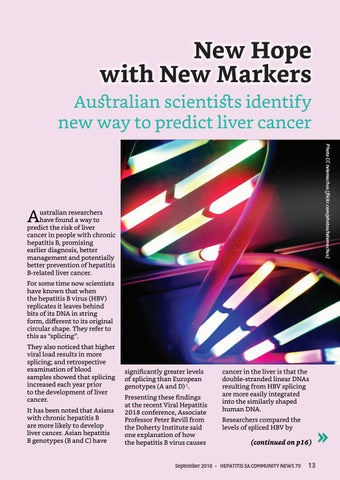New Hope with New Markers
Australian scientists identify new way to predict liver cancer Photo CC telemachus [flickr.com/photos/telemachus]
A
ustralian researchers have found a way to predict the risk of liver cancer in people with chronic hepatitis B, promising earlier diagnosis, better management and potentially better prevention of hepatitis B-related liver cancer. For some time now scientists have known that when the hepatitis B virus (HBV) replicates it leaves behind bits of its DNA in string form, different to its original circular shape. They refer to this as “splicing”. They also noticed that higher viral load results in more splicing; and retrospective examination of blood samples showed that splicing increased each year prior to the development of liver cancer. It has been noted that Asians with chronic hepatitis B are more likely to develop liver cancer. Asian hepatitis B genotypes (B and C) have
significantly greater levels of splicing than European genotypes (A and D) 1. Presenting these findings at the recent Viral Hepatitis 2018 conference, Associate Professor Peter Revill from the Doherty Institute said one explanation of how the hepatitis B virus causes
cancer in the liver is that the double-stranded linear DNAs resulting from HBV splicing are more easily integrated into the similarly shaped human DNA. Researchers compared the levels of spliced HBV by
(continued on p16)
September 2018 • HEPATITIS SA COMMUNITY NEWS 79
HepSA Community News 79.indd 13
»
13
3/10/2018 10:38:55 AM
